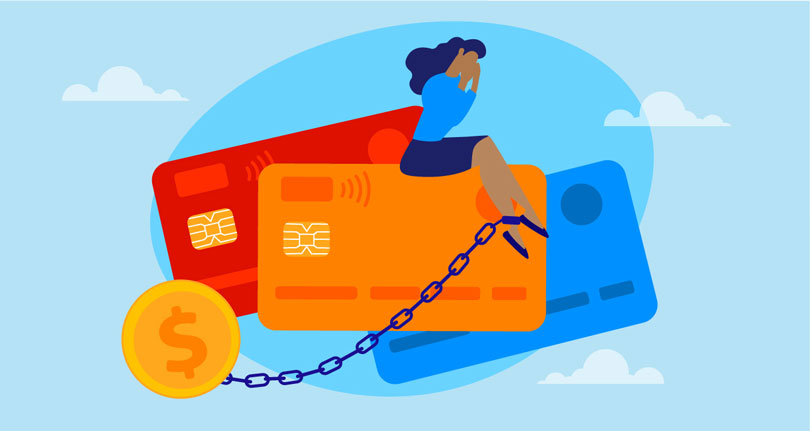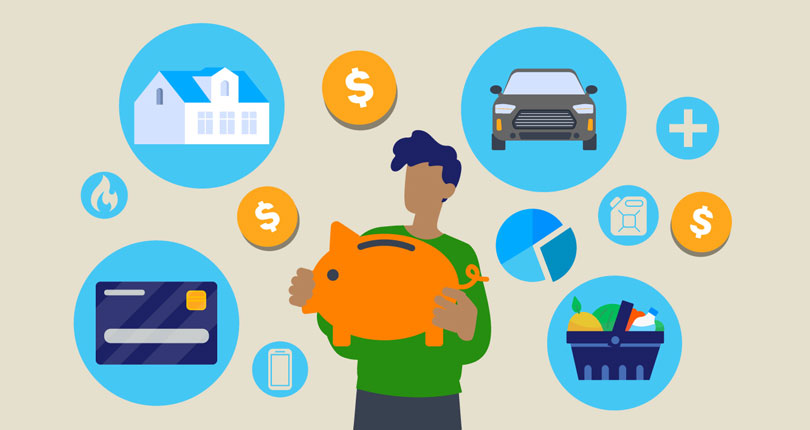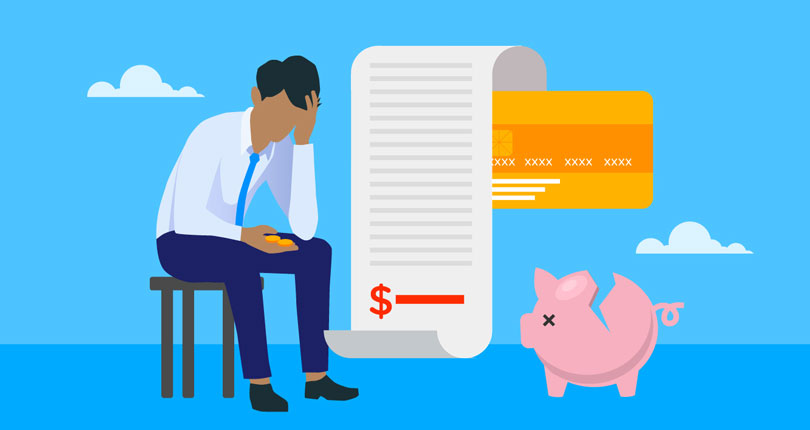Credit Card Debt and Bills Statistics 2023
Credit card debt is an issue that affects millions of Americans and can lead to long-term financial problems. This article takes an in-depth look at credit card debt and how it affects different demographics in the U.S., as well as how this type of debt has changed over time.
Key Statistics
- The average American has a credit card balance of $5,729, a 12.4% decrease from 2021’s figure.
- Out of all active credit accounts in the U.S., 53% carried a balance of some sort in Q4 of 2021.
- Alaska is the state with the highest average credit card debt per person at $7,338, while Wisconsin has the lowest at $4,808 per person.
- People aged 75 and over have the highest average amount of credit card debt at $8,080, but only 28% of people in this age group carry credit card debt, the lowest of all age groups.
- White people have the highest average amount of credit card debt compared to other races, at $6,940, Hispanics have $5,510, and Black people have the least at $3,940.
- People with college degrees have the highest levels of credit card debt ($7,940 on average) compared to other education levels.
Credit card debt statistics in the U.S.
The U.S. currently has $986 billion in total credit card debt as of Q4 2022. Credit card balances increased by $61 billion compared to the previous quarter, overtaking the pre-pandemic high of $927 billion. [1] Total Credit Card Debt in the U.S. https://www.newyorkfed.org/microeconomics/hhdc

How to Get a Credit Card with No Credit
It’s possible to get a credit card
with no credit, but you need to
know which types of accounts to
apply for (and which applications
to avoid as well).
Download our guide
The change in credit card balances and who holds debt
Since 1989, figures surrounding credit card debt in the U.S. have fluctuated. Using average figures for all families, credit card balances maintained a steady increase from 1989 ($3,760) to 2007 when the average amount of debt peaked at $9,050 during the financial crisis. Since that year, credit card debt per family declined quite steeply to $6,290 in 2013 and remained fairly consistent until 2019.
The percentage of families holding credit card debt peaked at 47.3% in 1995 and remained steady until after 2007 when it began to decrease, eventually dipping to a low of 38.1% in 2013. Since then, the figure has climbed back up, with the latest data showing 45.4% of families holding credit card debt as of the Federal Reserve’s 2019 Consumer Finance Survey.
| Year |
Credit Card Balances |
| 1989 |
$3,760 |
| 1992 |
$4,140 |
| 1995 |
$4,990 |
| 1998 |
$6,480 |
| 2001 |
$5,980 |
| 2004 |
$6,960 |
| 2007 |
$9,050 |
| 2010 |
$8,340 |
| 2013 |
$6,290 |
| 2016 |
$6,070 |
| 2019 |
$6,270 |
Source [2] Federal Reserve Credit Card Debt https://www.federalreserve.gov/econres/scf/dataviz/scf/chart/#series:Credit_Card_Balances;demographic:all;population:1;units:mean
| Year |
Percentage Holding Debt |
| 1989 |
39.70% |
| 1992 |
43.70% |
| 1995 |
47.30% |
| 1998 |
44.10% |
| 2001 |
44.40% |
| 2004 |
46.20% |
| 2007 |
46.10% |
| 2010 |
39.40% |
| 2013 |
38.10% |
| 2016 |
43.90% |
| 2019 |
45.40% |
Source [2] Federal Reserve Credit Card Debt https://www.federalreserve.gov/econres/scf/dataviz/scf/chart/#series:Credit_Card_Balances;demographic:all;population:1;units:mean
How many people in the U.S. have a credit card?
In the U.S. there are a total of 196 million credit card users and over 485 million credit card accounts which is an increase of 5% from the end of 2020 to the end of 2021. [3] Credit Card Users and Accounts https://www.transunion.com/blog/all-signs-point-to-a-healthy-credit-market-in-2022 Data shows that the average person has 3 credit cards, with the number of credit accounts increasing with age. As people tend to apply for more credit accounts throughout their lifetime, this progression is understandable.
| Year |
Number of Credit Card Accounts
|
| 2018 |
432.1 |
| 2019 |
456.8 |
| 2020 |
454.9 |
| 2021 |
486.9 |
How many Americans carry a balance on a credit card?
Data from the American Bankers Association shows that out of all the credit card accounts in the U.S., 40.1% carried a balance in the fourth quarter of 2021. Of the remaining accounts, 36.1% used a card but didn’t carry a balance, and 23.8% had a card but didn’t use it during this time period.
| |
Percent |
| Carried a balance |
40.1% |
| Used a card but didn't carry a balance |
36.2% |
| Had a card but didn't use it |
23.8% |
Source [4] Credit Card Accounts Carrying a Balance https://www.aba.com/news-research/research-analysis/credit-card-market-monitor
The same data also showed that out of all active card accounts in the U.S., 53% carried a balance at some point in the Q4, and 47% used their card but never carried a balance during that period.
Types of credit cards
There are a number of different types of credit cards someone could apply for. Some people may choose to use more than one credit card type when making different kinds of payments. Below are some of the most common credit cards you may come across:
- Rewards Credit Card - These typically give you points or cash back based on a percentage of your spending, so you can get bonuses for using your card. The bonuses you get depend on the credit card.
- Secured Credit Card - Most credit cards are unsecured, but with a secured credit card you’ll put down a deposit in order to secure a line of credit. This could mean you put down a $500 cash deposit to get a $500 line of credit. These are usually the easiest type of credit cards to get approved for and can be helpful for building credit from scratch or repairing your credit.
- Cash Back Credit Card - With these cards, you can earn cash back on your spending, either on specific categories like travel or groceries, or through a flat rate of rewards. The way the cash back is determined usually varies depending on the card you have.
- Business Credit Cards - If you own a business, having a credit card for it can help you separate your personal and business finances. These can help make running your business easier, and they can also double up as rewards cards, cash back cards, and other credit card types.
- Balance Transfer Credit Cards - If you’re dealing with some high-interest credit card debt, a balance transfer credit card can help you manage it. Some balance transfer cards give you an introductory 0% APR for 15 to 21 months, giving you time to pay off your existing debt without paying more interest. Most of these will require you to pay an upfront fee of 3% to 5%.
Credit card debt by state
Credit card debt statistics vary from state to state, the table below shows the full breakdown of credit card balances from each state. Combining the average amount of debt from each state gives us a U.S. average of $5,729, a percentage increase of 12.4% from 2021 when the average credit card debt was $5,097.
The state with the highest average credit card debt per person is Alaska, with $7,338, and the state with the lowest credit card debt is Wisconsin, at $4,808 per person. From 2021 to 2022, all states saw an increase in average credit card debt, with California’s being the highest at 17%.
| State |
2021 (Q3) |
2022 (Q3) |
% Change |
| U.S. Average |
$5,097 |
$5,729 |
+12.4% |
| Alabama |
$4,875 |
$5,364 |
+10% |
| Alaska |
$6,617 |
$7,338 |
+10.9% |
| Arizona |
$5,061 |
$5,755 |
+13.7% |
| Arkansas |
$4,670 |
$5,183 |
+11% |
| California |
$5,154 |
$6,030 |
+17% |
| Colorado |
$5,587 |
$6,274 |
+12.3% |
| Connecticut |
$6,052 |
$6,825 |
+12.8% |
| Delaware |
$5,357 |
$6,015 |
+12.3% |
| Florida |
$5,620 |
$6,408 |
+14% |
| Georgia |
$5,604 |
$6,265 |
+11.8% |
| Hawaii |
$5,525 |
$6,343 |
+14.8% |
| Idaho |
$4,539 |
$5,181 |
+14.1% |
| Illinois |
$5,315 |
$6,011 |
+13.1% |
| Indiana |
$4,528 |
$5,017 |
+10.8% |
| Iowa |
$4,285 |
$4,811 |
+12.3% |
| Kansas |
$5,029 |
$5,532 |
+10% |
| Kentucky |
$4,408 |
$4,894 |
+11% |
| Louisiana |
$5,054 |
$5,577 |
+10.4% |
| Maine |
$4,538 |
$5,078 |
+11.9% |
| Maryland |
$5,911 |
$6,668 |
+12.8% |
| Massachusetts |
$5,232 |
$6,046 |
+15.5% |
| Michigan |
$4,661 |
$5,265 |
+13% |
| Minnesota |
$4,754 |
$5,425 |
+14.1% |
| Mississippi |
$4,449 |
$4,912 |
+10.4% |
| Missouri |
$4,865 |
$5,417 |
+11.4% |
| Montana |
$4,778 |
$5,385 |
+12.7% |
| Nebraska |
$4,789 |
$5,312 |
+10.9% |
| Nevada |
$5,373 |
$6,176 |
+14.9% |
| New Hampshire |
$5,251 |
$5,944 |
+13.2% |
| New Jersey |
$5,995 |
$6,819 |
+13.8% |
| New Mexico |
$4,821 |
$5,350 |
+11% |
| New York |
$5,473 |
$6,269 |
+14.5% |
| North Carolina |
$5,101 |
$5,658 |
+10.9% |
| North Dakota |
$4,874 |
$5,408 |
+11% |
| Ohio |
$4,808 |
$5,320 |
+10.7% |
| Oklahoma |
$5,155 |
$5,654 |
+9.7% |
| Oregon |
$4,630 |
$5,316 |
+14.8% |
| Pennsylvania |
$5,026 |
$5,640 |
+12.2% |
| Rhode Island |
$5,153 |
$5,867 |
+13.9% |
| South Carolina |
$5,176 |
$5,714 |
+10.4% |
| South Dakota |
$4,591 |
$5,071 |
+10.5% |
| Tennessee |
$4,891 |
$5,432 |
+11.1% |
| Texas |
$5,820 |
$6,542 |
+12.4% |
| Utah |
$4,831 |
$5,535 |
+14.6% |
| Vermont |
$4,595 |
$5,159 |
+12.3% |
| Virginia |
$5,864 |
$6,477 |
+10.5% |
| Washington |
$5,231 |
$6,043 |
+15.5% |
| Washington, D.C. |
$5,949 |
$6,904 |
+16% |
| West Virginia |
$4,574 |
$5,005 |
+9.4% |
| Wisconsin |
$4,329 |
$4,808 |
+11.1% |
| Wyoming |
$5,159 |
$5,745 |
+11.4% |
Source [5] Credit Card Debt by State https://www.experian.com/blogs/ask-experian/state-of-credit-cards/
Credit card debt by age
Statistics on credit card debt tend to vary by age, with the amount of debt and the percentage of people carrying debt changing for different age groups.
The latest data from the Federal Reserve’s 2019 Survey of Consumer Finances shows that people aged 75 or over have the largest average amount of debt at $8,080. People younger than 35 have the lowest credit card balances at an average of $3,660.
When looking at the percentage of people in each age group who carry debt, the 45-54 age group has the most with 52%, closely followed by the 35-44 age group at 51%. People aged 75 and over, who have the highest average amount of debt, actually have the lowest percentage of people with credit card debt at 28%.
| Age Group |
Average Credit Card Debt |
| Younger than 35 |
$3,660 |
| 35-44 |
$5,990 |
| 45-54 |
$7,670 |
| 55-64 |
$6,880 |
| 65-74 |
$7,670 |
| 75 or older |
$8,080 |
Source [8] Federal Reserve - Average Credit Card Debt by Age https://www.federalreserve.gov/econres/scf/dataviz/scf/chart/#series:Credit_Card_Balances;demographic:agecl;population:all;units:mean
| Age Group |
Average Credit Card Debt |
| Younger than 35 |
$3,660 |
| 35-44 |
$5,990 |
| 45-54 |
$7,670 |
| 55-64 |
$6,880 |
| 65-74 |
$7,670 |
| 75 or older |
$8,080 |
Source [8] Federal Reserve - Average Credit Card Debt by Age https://www.federalreserve.gov/econres/scf/dataviz/scf/chart/#series:Credit_Card_Balances;demographic:agecl;population:all;units:mean
Credit card debt by race
Credit card debt data also varies by race when it comes to the amount of debt people carry. White people have the highest average amount of debt at $6,940, and Black non-Hispanic people have the lowest with an average of $3,940 in credit card debt.
The percentage of people carrying credit card debt is similar across all races, but Hispanics have the highest percentage of people with debt at 50%. You can see the full breakdown of credit card debt among different races in the table below.
| Race |
Average Credit Card Debt |
| White, Non-Hispanic |
$6,940 |
| Black, Non-Hispanic |
$3,940 |
| Hispanic |
$5,510 |
| Other |
$6,320 |
Source [9] Federal Reserve - Credit Card Debt by Age https://www.federalreserve.gov/econres/scf/dataviz/scf/chart/#series:Credit_Card_Balances;demographic:racecl4;population:all;units:mean
| Race |
Percentage with Debt |
| White, non-Hispanic |
45% |
| Black, non-Hispanic |
48% |
| Hispanic |
50% |
| Other |
44% |
Source [9] Federal Reserve - Credit Card Debt by Age https://www.federalreserve.gov/econres/scf/dataviz/scf/chart/#series:Credit_Card_Balances;demographic:racecl4;population:all;units:mean
Credit card debt by educational level
Statistics from the Federal Reserve show that there is a difference between levels of credit card debt when it comes to someone’s educational level. The data shows that people with a college degree have the highest levels of credit card debt, with the average credit card balance for a college graduate being $7,940.
People with no high school diploma have the lowest average levels of credit card debt at $3,390, and those with a high school diploma but no college degree fall in the middle with $4,940.
Take a look at the graph below to see the breakdown of credit card debt by different education levels.
| Year |
No high school diploma |
High school diploma |
College degree |
| 2001 |
$2,860 |
$5,270 |
$8,230 |
| 2004 |
$4,930 |
$6,050 |
$8,950 |
| 2007 |
$5,320 |
$7,340 |
$13,650 |
| 2010 |
$4,240 |
$6,940 |
$11,960 |
| 2013 |
$3,810 |
$4,780 |
$8,580 |
| 2016 |
$4,080 |
$4,940 |
$8,710 |
| 2019 |
$3,390 |
$4,940 |
$7,940 |
Source [10] Federal Reserve - Credit Card Debt by Education Level https://www.federalreserve.gov/econres/scf/dataviz/scf/chart/#series:Credit_Card_Balances;demographic:edcl;population:all;units:mean
Why do college-educated people have more credit card debt?
According to Elizabeth Aldrich at fool.com, there are a few reasons why people with a college degree might have more credit card debt than people without one. Let’s take a look at some of the factors which can affect this difference. [6] Why Do College Educated People Have More Credit Card Debt? https://www.fool.com/the-ascent/credit-cards/articles/study-americas-most-educated-have-most-credit-card-debt
- Student loans - Many college students use loans to help them pay for tuition and other educational expenses. This often leaves them with large amounts of debt to pay off when they graduate, and making loan repayments means they have less disposable income and are more likely to use credit cards if their income doesn’t quite cover their spending.
- Better access to credit - People with a Bachelor’s degree or higher often tend to make more money than those without a degree. This means they are more likely to be approved for higher credit limits, giving them the ability to get into larger amounts of debt which someone with a lower credit limit wouldn’t have.
- Trying to maintain a certain lifestyle - A pattern known as ‘lifestyle creep’ among the college-educated involves spending money on luxury items as incomes increase. This habit of trying to maintain a more luxurious lifestyle can lead some to spending more than they earn, and subsequently getting into credit card debt.
College student credit card debt
For college students, getting into debt with a student loan can be a common occurrence, but how does credit card debt affect college students? As we mentioned, people who have graduated from college are more likely to experience credit card debt. Let’s look at the stats for people who are still studying at college.
Data from a College Finance survey of 625 college students [7] Student Credit Card Debt Survey https://collegefinance.com/research/college-student-debt-and-credit-card-usage shows that college students have over $3,280 worth of credit card debt on average, and 68.4% of college students have some type of credit card debt. Below are some more key statistics for credit card debts among college students:
- On average, college students have 2.1 credit cards, with a limit of $3,568.
- Students reported getting their first credit card at approximately 19.7 years old.
- The most common reason people in college used their credit card was for online shopping, with 70.1% saying they used their card for this type of spending.
- Other types of spending students used a credit card for were dining (50%), gas (44.4%), groceries (40.6%), and travel (35.2%).
Avoiding credit card debt
Credit cards can be helpful financial tools when it comes to spreading the costs of your purchases or getting rewards when you spend. But it’s important to be mindful of your credit card use so you don’t get into a difficult situation. Let’s look at some tips for avoiding credit card debt:
- Set up an emergency fund - When faced with unexpected costs, it can be tempting to use a credit card to make sure your car gets fixed, or that roof leak is repaired. But if you don’t have the money when the payment is due, you could find yourself in debt. Setting up an emergency savings fund can prepare you for these costs so you don’t need to rely on a credit card.
- Save up for things you want - If there’s something you really want to buy but can’t afford right now, save up for it over time instead of putting it on a credit card. Try to only use credit to buy things you can afford to pay off right away.
- Make sure you pay on time - Missing a payment will incur late fees and you’ll end up paying more than the original cost of the purchase. This can lead you into a vicious cycle of trying to catch up on your bills and added fees. Paying your bill on time every time helps you avoid this problem.
Sources







